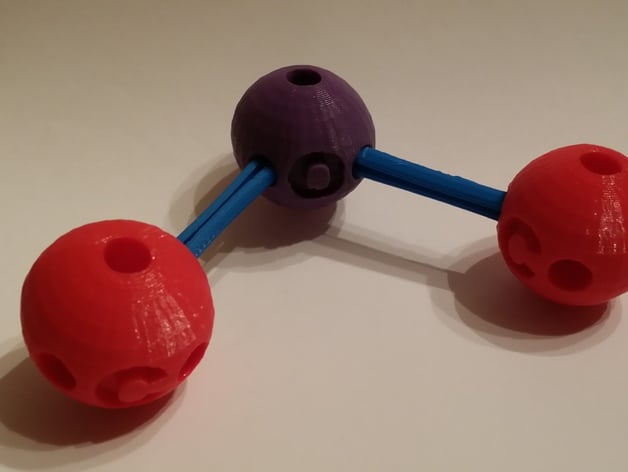
Molecules and Compounds
thingiverse
Introduce chemical formulas of common compounds and model how to build molecules using the 3D printed atoms and connectors. Print Settings Printer Brand: MakerBot Printer: MakerBot Replicator 2 Rafts: Yes Supports: No Resolution: Standard Infill: 10% How I Designed This The 3D printed parts were designed in Tinkercad. Overview and Background Introduce chemical formulas of common compounds, model how to build molecules, and have printed pieces available to students for modeling. Objectives Students use chemical formulas for common compounds to experiment with how atoms come together to make molecules Audience 5-6th Grade Subjects Chemistry Skills Learned (Standards) 1.b. Students know all matter is made of atoms, which may combine to form molecules. 1.d. Students know that each element is made of one kind of atom and that the elements are organized in the periodic table by their chemical properties. Lesson Plan and Activity Background A chemical compound is a combination of two or more different elements that are bonded together and take on new physical and chemical properties from the individual elements. For example, rust is a chemical compound of iron and oxygen. Similar to how scientists write a chemical symbol for a single element, compounds are written as chemical formulas. A chemical formula identifies each element by its chemical symbol and indicates the number of atoms of each element in that compound. If a molecule of a certain compound contains more than one atom of a particular element, this quantity is indicated using a subscript number after the chemical symbol. For example, the chemical formula for rust (or iron oxide) is Fe2O3; which is made up of 2 atoms of iron (Fe) and 3 atoms of oxygen (O). When elements join to form compounds, they lose their original properties and take on new ones. Once combined into iron oxide, the individual iron (which is shiny) and oxygen (which is a gas) molecules lose their original properties and take on new ones; thus creating a new compound Modeling 1 Model how to make a compound by using salt as an example. Find the chemical formula for salt on the Molecules and Compounds worksheet. Using the periodic table of elements, locate Na and Cl. Explain that using the chemical formula as a guide, we know that a salt molecule is made of one sodium atom (Na) and one chlorine atom (Cl) Create a salt molecule by putting 1 Na and 1 Cl atom together. Model how to identify the atoms within a more complex molecule like emerald (Be3Al2SiO6) using the periodic table to determine the type and number of atoms are in an emerald molecule. (3 Beryllium, 2 Aluminum, 1 Silicon, and 6 oxygen for a total of 12 atoms.) If needed, have students create another simple molecule such as carbon dioxide (CO2) Have the student fill out the Element section of the Molecules and Compounds worksheet. Guided Practice 1 Working in pairs, students will assemble a unique molecule using the appropriate 3D printed atom, the name of the molecule, and its chemical formula. Have the students fill in the compound section of the worksheet. List the compound’s name, its chemical formula, and how many of each type of atom. Modeling 2 Model how to determine the identity of a mystery molecule by counting and identifying the atoms. Model how to complete the second box of the worksheet by counting atoms, writing out the chemical formula, and finding the name of the compound. Guided Practice 2 Students will swap molecules with neighboring groups and identify the “mystery molecule.” After carefully counting atoms, they should correctly identify the new compound. Materials Needed To prepare for this lesson you will need the following supplies: Multiple prints of the various elements found on the Molecules and Compounds worksheet. A few dozen large and small connectors for connecting the molecules together The Compounds and Molecules worksheet Access to Periodic Table of Contents (One is included in downloads) Using the chemical formulas as a guide, prepare the correct number of labeled atoms for each group to create their assigned molecule. Include one Na and one Cl atom so each group can create a salt (NaCl) molecule and an extra C and 2 O’s so they can create a carbon dioxide (CO2) molecule. Duration of Lesson 90 minutes Rubric and Assessment Check student’s work to make sure they have correctly counted the atoms for each molecule. How did you know how many to put together for your molecule? What elements make up sugar? How are sugar and vitamin C similar? How are they different? How many atoms make up an aspirin molecule? If you took away a hydrogen atom would you still have the same compound? Handouts & Assets Periodic Table of Elements PDF Molecules and Compounds Worksheet PDF References http://www.tnn.com.au/elements-their-symbolshttp://www.periodni.com/solcalc-chemical_compounds.htmlhttp://www.softschools.com/examples/science/molecules_examples/160/
With this file you will be able to print Molecules and Compounds with your 3D printer. Click on the button and save the file on your computer to work, edit or customize your design. You can also find more 3D designs for printers on Molecules and Compounds.
